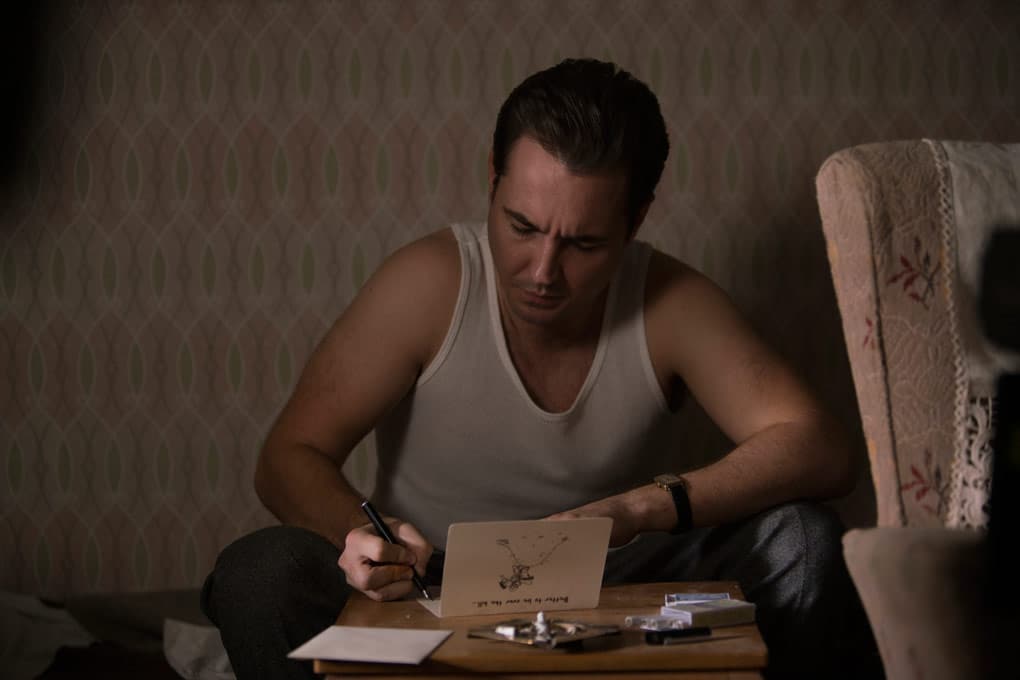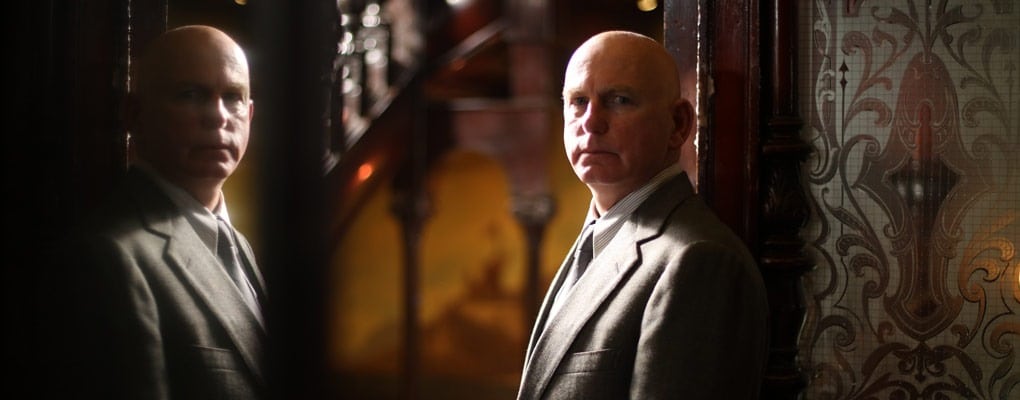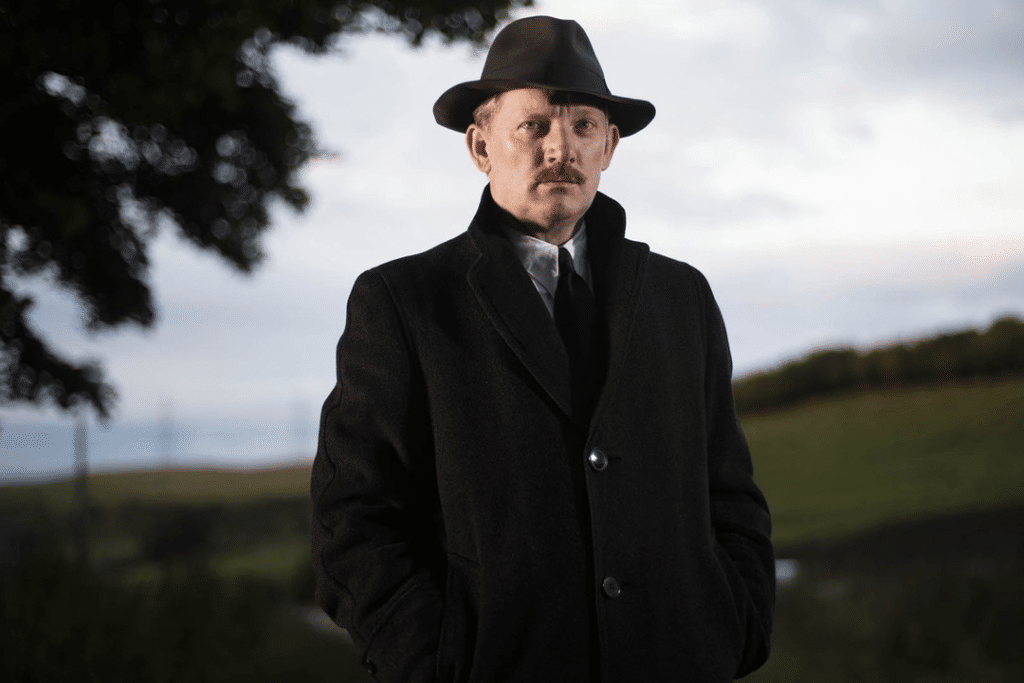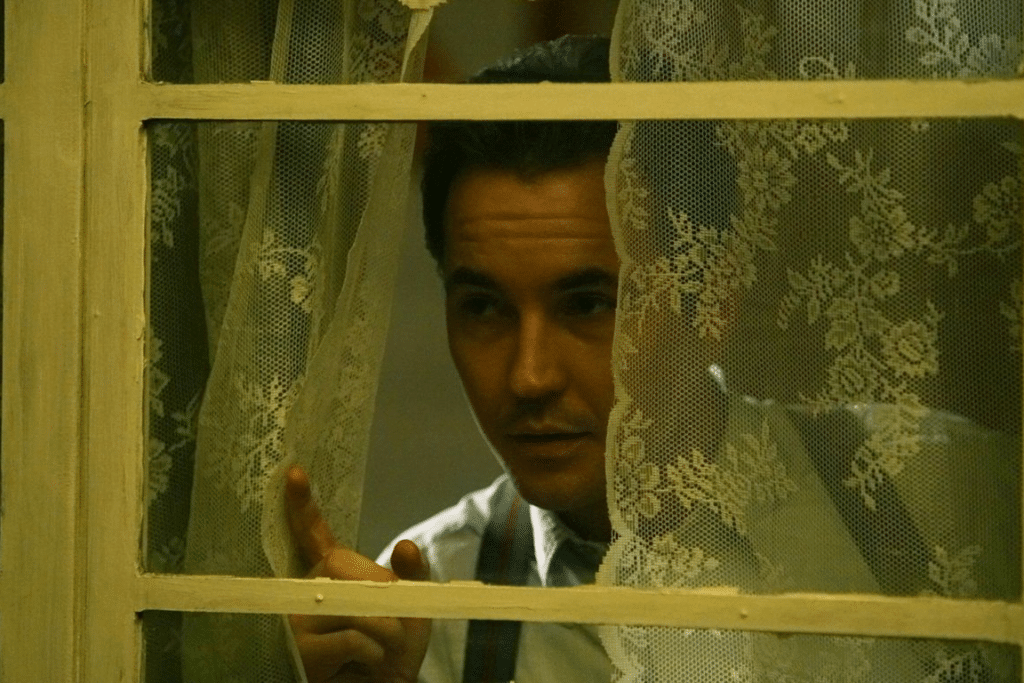ITV’s new crime drama In Plain Sight reopens a case file from the past – that of Peter Manuel who committed a string of crimes in Lanarkshire in the mid fifties. This first of three episodes was a gripping two hander. Writer Nick Stevens has chosen to frame the true story as a battle of wills between villain and hero. Very much light and dark, good versus evil.
The force of good is the virtuous Detective Muncie, played by Douglas Henshall. The story begins as he celebrates his 40th birthday. A shadow lurks on the fringes of the celebration, when the detective gets a birthday card that clearly disturbs him. The card is from Manuel, who has recently returned to the community of Uddingston after serving a nine-year stretch for a series of sexual assaults. It was Muncie who secured his conviction and he is harbouring a grudge.
Played by Line of Duty’s Martin Compston, Manuel is cocksure and cunning. Compston gives off heavy creep vibes from the moment he appears on screen. Despite a flashback scene to an interrogation where a then uniformed Muncie strikes Manuel, there is no shadow of doubt that this is a very bad man who deserves it. In contrast to Compston’s swaggering, Henshall plays Muncie as measured and deliberate in his movements, expending no excess energy.

In Plain Sight episode 1 may have clearly dressed its central characters in figurative white and black hats, but the environment in which the story unfolds is painted in shades of grey – literally the colour of the period housing. When Manuel attacks Mary McLauchlan (Jenny Hulse), a young woman coming home from a dance, he holds her at knife point for three hours before insisting on walking her home. “It’s the least I can do”.
When the crime is reported, Muncie recognises the duration of the incident as unusual. However, he runs a methodical and professional investigation gathering convincing evidence against Manuel. At trial, the accused mounts his own defence. Distressingly this enables him to cross examine his victim. By suggesting they were in a pre-existing relationship – a lie – Manuel uses those three hours to convince a jury this was a straightforward lover’s tiff, and the victim as a vindictive woman scorned. Using shame and social conventions against a victim gives the drama disturbing contemporary relevance.
Manuel and McLauchlan live on the same estate. After the failed trial, she must travel on the same bus as her assailant and his father spits in her face. When she goes back to the dance-hall, every head turns.
Despite the coldness of the setting – Scotland in winter – and drab working class surroundings, director John Strickland injects energy with the dance-hall sequences, which feature a live skiffle soundtrack. The period detail is excellent, and particularly fascinating was the procedural detail of a forensic investigation of the day, long before DNA evidence.
This drama suggests that evil not only resides in the heart of a community: it may actually thrive there – as the title has it – In Plain Sight.
Did you tune in for In Plain Sight episode 1? Let us know your thoughts in the comments below!
Still catching up on In Plain Sight episode 2? Read Stuart’s review of episode 1 here.
Now that we have been properly introduced to detective Muncie (Douglas Henshall) and his murderous quarry Peter Manuel (Martin Compston) episode 2 of true crime drama In Plain Sight picked up its pace. Nick Stevens’ script compressed a full year into less than an hour and director John Strickland kept the action motoring along.
At the close of episode 1, serial rapist Manuel had escalated to murder. A young woman’s body is discovered on a golf course after Hogmanay. In Plain Sight episode 2 jumped forward 9 months later to September of 1956. Muncie believes Manuel is the killer but he has an alibi from his father and the investigation has stalled. Then Lanarkshire is shocked by a triple murder – a mother and two daughters killed in their home. Muncie suspects Manuel, but the choice of a gun as the murder weapon and the fact the victims were reported to have been killed in their sleep does not fit his MO.
The investigating officer — Muncie’s superior — arrests Bill Watts (Gary Lewis), the family patriarch. Watts had been staying at a hotel that night after quarrelling with one of his daughters. A witness reports having seen him on the road towards the family home.

This episode delved deeper into Manuel’s deeply scary psychology, and presented Muncie as a detective ahead of his time in his understanding of what drives a serial killer. Muncie’s superior dismisses Manuel as a suspect because he has no motive. In a rare show of exasperation Muncie exclaims “he’s a psychopath!” Manuel does not possess a motive beyond the pleasure he takes in his crimes. He is a braggart and a peacock, craving attention. Muncie claims that he wants to be arrested, but only after he has proven he is a criminal mastermind. This is a game, one where the killer is the master of ceremonies, leading the police on a merry dance.
Compston is terrific as Manuel, a vain and loathsome man but one with a sense of theatre. When he is found guilty on a burglary charge and sent to Barlinnie Prison he takes his mind games to new levels. Watts is also incarcerated there and Manuel passes him a note claiming he knows who murdered his family. Watts’ lawyer (Denis Lawson) meets with Manuel who, when asked who was the killer, gleefully replies “it was me” followed by a dramatic pause that would have embarrassed William Shatner before “…who sold him the gun”.
Manuel’s mania is escalating. When he is released after his short time in jail Muncie grimly notes that he has a history of violence around the holiday season, and Christmas is just around the corner.
The elaborate mind games and Jack the Ripper-esque letters taunting the authorities are remarkable examples of arrogance. Manuel is so like a pulp fiction version of a serial killer that this case must have influenced some of fictional portrayals psychopathic killers. This point is emphasised by the episodes final twist, which was amazingly close to a key moment in the film Se7en.
Did you tune in for In Plain Sight episode 2? Let us know your thoughts in the comments below!
Join the discussion
Please note: Moderation is enabled and may delay your comment being posted. There is no need to resubmit your comment. By posting a comment you are agreeing to the website Terms of Use.
Still catching up on In Plain Sight episode 3? Read Stuart’s review of episode 2 here.
In the concluding part of In Plain Sight the battle of wills between serial killer Peter Manuel (Martin Compson) and Detective William Muncie (Douglas Henshall) reaches its end game. A young woman, Isabelle Cooke, has gone missing. She was seen at a Christmas dance, but never returned home. Muncie believes her to be Manuel’s latest victim.
In a brazen act of hubris Manuel walks into Muncie’s police station to proclaim his innocence whilst winking lasciviously at the female WDC Iris Laird. Muncie knows Manuel has murdered Isabelle Cooke, Manuel knows Muncie knows, and they both know that without a body there is no case.
Muncie has officers shadowing Manuel but he appears to revel in the attention. As the bells ring for 1958, he slips out of the family home to commit a triple murder with no more a motive than to give him a feeling of intellectual superiority to the police. Manuel has a weakness in his craving of recognition. Muncie tells his officers that the only person who wants Manuel caught as much as they do is Peter Manuel himself.
Muncie is ahead of the curve in his understanding of a criminal psychopath, but is stymied in his investigation because others need to be provided with clear motives. Manuel choses victims solely based on convenience. There is no connection between his victims and he doesn’t steal from them. Increasingly it seems that his real aim is humiliating Muncie.
However, the investigation receives a breakthrough when Manuel does steal from a murder victim. Traceable notes link him to the crime and give Muncie cause to make an arrest. He has WDC Laird conduct the interview to attack his masculine pride. Muncie is using Manuel’s psychology against him.
In boiling down the story into a clear battle between good (Henshall’s soft spoken and controlled detective) and evil (Compson’s swaggering, stylishly dressed, killer spiv), writer Nick Stevens places the story as a real life inspiration for the criminal profiler vs charismatic psycho sub genre that became popular in the wake of the success of Thomas Harris’ novels Red Dragon and The Silence of the Lambs. Indeed Scottish actor Brian Cox has claimed Manuel was a loose influence on his version of Harris’ most famous creation Hannibal Lector.
The narrowing of focus onto the detective and the psychopath is at the expense of context. In this episode, we are told that panic has spread across Lanarkshire in the wake of the killings, and women aren’t walking home alone at night. Yet we see very little evidence of this.
The series has been soberly filmed, with the winter setting adding to a grey (some might say drab) aesthetic. The mood was broken by one instance of clumsy visual shorthand. When Muncie confronted Manuel’s parents with evidence of his crimes, his mother drops and breaks a picture of her son and the glass over his photograph shattered. A moment of symbolism that landed with the weight of a fridge dropped out of a third floor tenement window.
This has been a solid, if unspectacular, true-crime drama elevated by the contracting performances of Henshall and Compson. The TV equivalent of a satisfying pulp paperback.
Did you tune in for In Plain Sight episode 3? Let us know your thoughts in the comments below!
Join the discussion
Please note: Moderation is enabled and may delay your comment being posted. There is no need to resubmit your comment. By posting a comment you are agreeing to the website Terms of Use.






Please note: Moderation is enabled and may delay your comment being posted. There is no need to resubmit your comment. By posting a comment you are agreeing to the website Terms of Use.